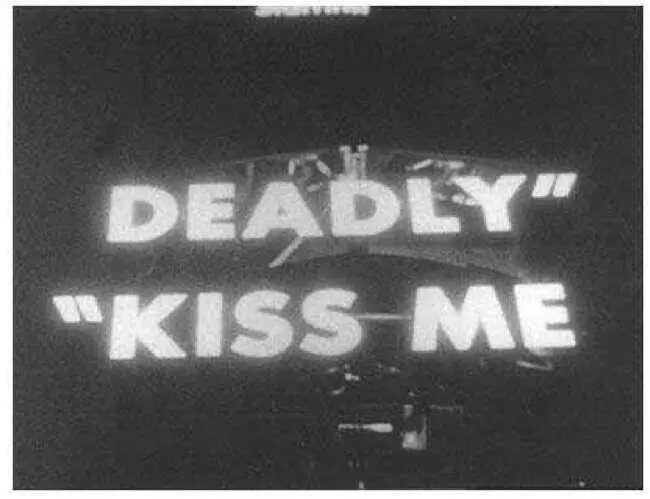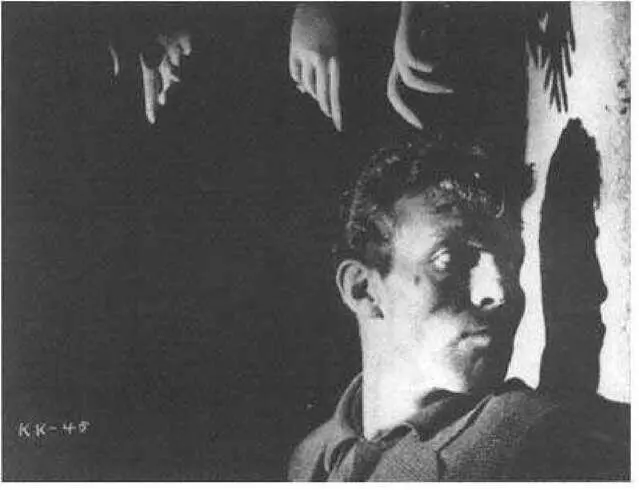
Turning Mickey Spillane upside down.
Unfortunately, none of these attributes were noted by the Anglo-American critical establishment in 1955. Perhaps Spillane's sensational reputation obscured what Aldrich had done, or perhaps the meaning of the film has changed over time. In any case, when Kiss Me Deadly was originally released, The New York Times did not review it, the Legion of Decency condemned it, the British banned it altogether, and United Artists had difficulty advertising it in midwestern and southern towns. The French, however, passionately embraced it, and because of their somewhat ironic interpretation, it eventually became one of the most admired films of the decade. Today, in the various culinary guides to classic videos and TV movies, it receives multiple stars. A quintessential example of how a supposedly "cheap" artifact can acquire an aura, it is universally regarded as a masterpiece of noir.
When Kiss Me Deadly was released in 1955, the B-picture industry was already dead, and most studios that financed medium-budget thrillers were in economic trouble. Republic and Allied Artists were unsuccessfully producing intermediate and A pictures, Howard Hughes was in the process of selling RKO to General Tire and Rubber, and Charles Chaplin was divesting himself of one-quarter ownership in United Artists. Two of the most successful mainstream films of that year were Warner Brothers' Rebel without a Cause and MGM's Blackboard Jungle. Also in 1955, Samuel Z. Arkoff and James H. Nicholson founded American International Pictures. The movies were discovering the youth market, and a new age of exhibition, sometimes called the schlock-exploitation era, was about to begin.
Evidence of the changing times could be seen in two perversely violent, erotically charged thrillers of 1955neither of them addressed to teenagers, and neither of them especially successful at the box office. First was The Big Combo, an intermediate-level production from Allied Artists, directed by Joseph H. Lewis and featuring a number of aging, not-quite stars (Cornell Wilde, Richard Conte, Brian Donlevy). Second was Killer's Kiss, a seventy-five-thousand-dollar independent feature distributed through United Artists, produced and directed by Stanley Kubrick, and performed by a small cast of unknowns. The Lewis picture, which was impressively photographed by John Alton, has subsequently acquired a cult reputation because of its skillful treatment of repressed, sadomasochistic relationships; nevertheless, it remains a studioish throwback to the kind of thing Hollywood was doing five years earlier, and it looked dated even when it was released. In contrast, the Kubrick thriller was innovative and virtually handmade, like a protoart film disguising itself as a genre movie and crossing over to the lowest levels of theatrical exhibition.
In its style and mode of production (if not in its sexual politics), Killer's Kiss is ahead of its time, whereas The Big Combo is relatively antiquated. British critic Chris Hugo observes that it would be almost impossible in the contemporary theatrical marketplace to create a middle-budget, widely distributed equivalent of the Lewis picture. Such a film could succeed, he argues, only as "a minority-interest independent feature, with distribution aimed at art houses," and it would no doubt become "mannered and self-consciously referential to film noir of the past, as this 'cultural capital' would be its chief selling point" (Cameron, 253). In comparison, a sophisticated but inexpensive feature like Killer’s Kiss already has many of the qualities Hugo describes and would be relatively easy to duplicate. In fact, Matthew Chapman's Strangers Kiss (1984), a contemporary low-budget movie about the making of a low-budget movie, uses thinly disguised scenes from Killer's Kiss for its film-within-the-film, which is directed by a character named Stanley.

Killer’s Kiss (1955).
(Museum of Modern Art Stills Archive.)
Kubrick's perverse story about a triangle of sexual obsession between a gangster, a dancehall girl, and a prizefighter was produced before the art-theater marketplace had fully emerged, and it was filmed so cheaply that it has almost no direct sound recording or dialogue. The opening sequence borrows a few images from Kubrick's earlier nonfiction short, Day of the Fight (1951), and later scenes are photographed with a hidden camera as the players mingle with the nighttime crowds on Times Square. Throughout, Kubrick uses 1940s-style narration as a substitute for speech, and he often composes over-the-shoulder shots in order to hide lip movements. (He also stages conversations on telephones, which makes the work of dubbing much easier.) His cost cutting sometimes results in an abstract or symbolic effect, reminiscent of the avant-garde. Midway through the film, a flashback-within-a-flashback allows the dime-a-dance girl to take over the narration from the prizefighter: her elaborate story is illustrated by nothing more than the image of a ballerina dancing against a black limbo.
The most impressive sequences of Killer's Kiss employ the style of artful, New York-school street photographyespecially in a protracted sequence in Times Square, where Kubrick digresses from the main action to show a couple of clownish figures in Shriner's hats dancing up and down the sidewalk. On another but equally important level, the film deals somewhat archly with the subject matter of pulp fictionas when the mulatto-looking gangster gropes at his aristocratic blond employee while forcing her to watch a boxing match on TV; or when a couple of thugs kidnap the woman and tie her up in a Greene Street loft, where she uses her sexual charm to get out of trouble. At certain junctures, Kubrick seems to be gathering motifs from more expensive movies (Body and Soul, The Lady from Shanghai, and Rear Window) and weaving them into a highly choreographed and rather knowingly sadomasochistic fantasy. One of the most unnerving implications of his approach becomes evident in the climactic fight scene between the hero and the villain, which rivals the mirror-maze in The Lady from Shanghai for misogyny and surrealistic invention. The battle takes place in a darkened loft filled with female mannequins from a department store, and the two men throw women's body parts at one another; eventually they seize a spear and a fire ax, but they swing out wildly, impaling stray torsos, chopping off arms and heads, and reducing the nude females to rubble.
At about the time Killer's Kiss was released, art-movie noirs began to appear with some regularity on the international scene. Artisanal, somewhat cinema-verité productions, they were usually directed by American independents or by new-wave Europeans, who used melodramatic conventions for atypical purposes. (Orson Welles produced his own low-budget thriller, Mr. Arkadin, in 1955, slightly ahead of the art-movie distribution system that might have made it successful.) One of the earliest and best examples was Irving Lerner's Murder by Contract (1958), which was photographed in only seven days by Lucian Ballard, and which later exerted a strong influence on Martin Scorsese's Taxi Driver. A deadpan black comedy about the American dream, this film starred hirsute TV actor Vince Edwards in the role of a highly disciplined hit man who wants to "improve" himself so that he can buy a home on the Ohio River. 24At several points, we see the dour, emotionally repressed killer waiting alone in drab hotel rooms for his assignments, passing the time by balancing his bankbook and doing chin-ups and push-ups. After murdering several people (including the man who originally hired him), he is sent by the Mob to Los Angeles, where he is supposed to assassinate a female witness in an upcoming trial. "If I'd known it was a woman," he says, "I would have asked double. I don't like women. It's tough to kill someone who's not dependable." While planning the crime, he swims at Malibu, plays miniature golf, and engages in a long, abusive monologue with a hotel bellboy who inadvertently brings him a lipstick-stained coffee cup. He also visits a gun shop, and he tells one of his fellow gangsters that the place seems crazy because it doesn't sell antitank weapons to anyone from off the street. "To get that gun you have to have a license and be a civilized country," his companion says defensively. "Are you a civilized country?"
Читать дальше














